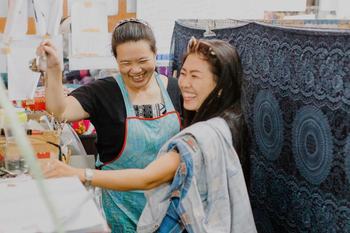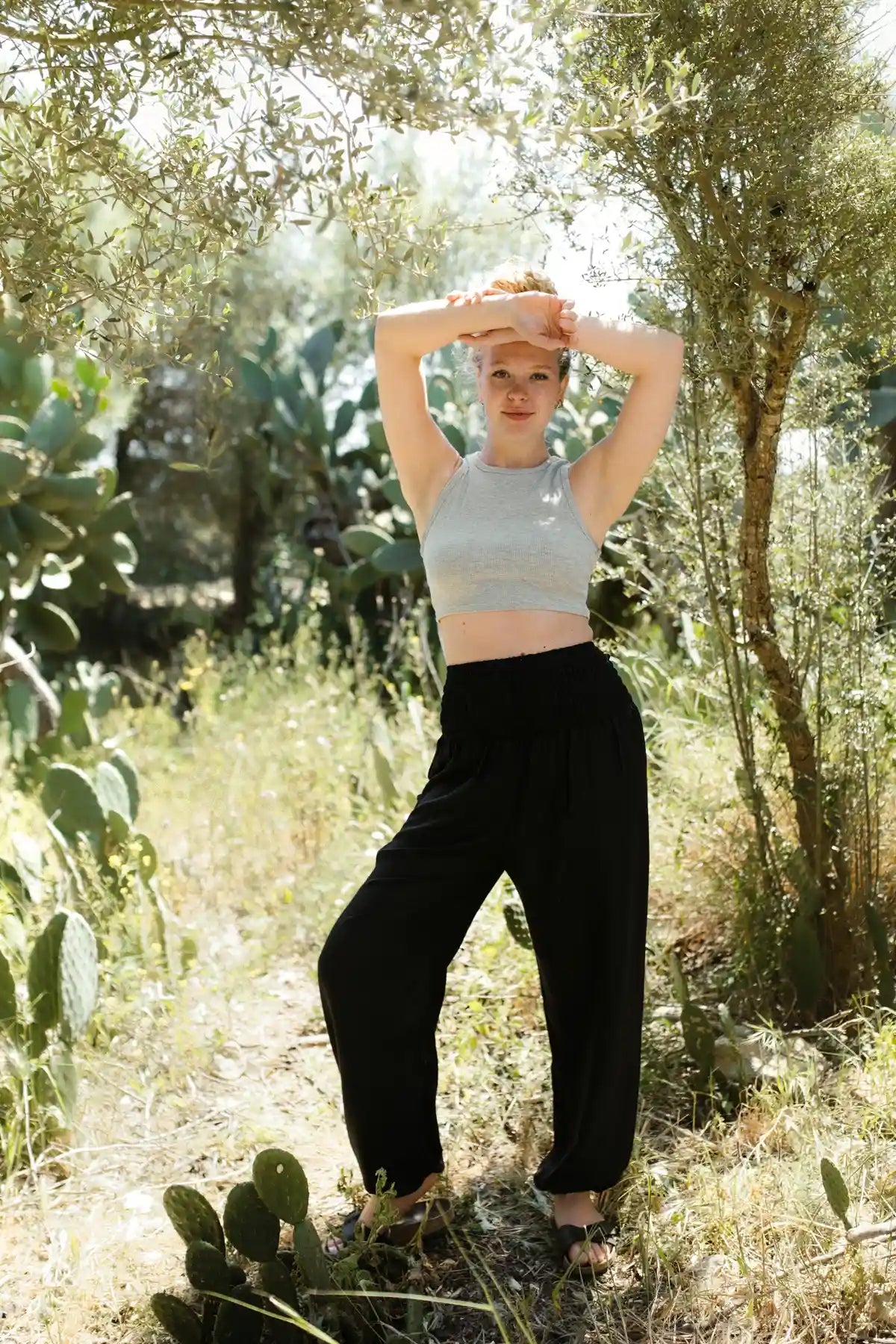
Inhaltsverzeichnis
6 Gründe für nachhaltige Kleidung
In einer Welt, die zunehmend von den Auswirkungen des Klimawandels, der Umweltverschmutzung und sozialer Ungerechtigkeiten betroffen ist, gewinnt das Thema Nachhaltigkeit in allen Lebensbereichen an Bedeutung – besonders in der Modeindustrie. Die Entscheidung für nachhaltige Kleidung geht über ein modisches Statement hinaus. Es ist eine bewusste Wahl, die unseren Planeten schützt, faire Arbeitsbedingungen fördert und eine verantwortungsvolle Konsumkultur unterstützt.
Was spricht für nachhaltige Kleidung? Für nachhaltige Kleidung spricht, dass sie zur Reduzierung von Umweltschäden beiträgt, indem sie den Verbrauch natürlicher Ressourcen minimiert und auf schädliche Chemikalien verzichtet. Zudem fördert sie faire Arbeitsbedingungen und gerechte Löhne in der Textilindustrie. Nachhaltige Kleidung unterstützt somit eine umweltfreundlichere und sozial gerechtere Modeindustrie und hilft Verbrauchern, bewusstere und ethisch verantwortungsvolle Entscheidungen zu treffen.
In diesem Beitrag beleuchten wir die vielfältigen Gründe, warum nachhaltige Kleidung nicht nur eine Option, sondern eine Notwendigkeit für eine bessere Zukunft ist. Von der Verringerung umweltschädlicher Praktiken bis hin zur Unterstützung ethischer Produktionsstandards – die Wahl für Nachhaltigkeit im Kleiderschrank hat weitreichende positive Effekte.
Die Bedeutung von Nachhaltigkeit in der Mode
Nachhaltigkeit in der Modeindustrie ist von entscheidender Bedeutung, da diese Branche zu den umweltschädlichsten und sozial problematischsten Sektoren weltweit zählt. Die traditionelle Modeproduktion ist für einen erheblichen Anteil an Wasserverbrauch, CO₂-Emissionen und der Generierung von Textilabfällen verantwortlich. Des Weiteren werfen die Arbeitsbedingungen und die faire Bezahlung der Arbeiter in den Produktionsländern ethische Bedenken auf, welche die Branche belasten.
Nachhaltige Mode adressiert diese Probleme durch verschiedene Ansätze und setzt sich zum Ziel, die negativen Auswirkungen auf die Umwelt zu minimieren und soziale Gerechtigkeit zu fördern.

Umweltauswirkungen der Modeindustrie
Die Modeindustrie ist einer der größten Wasserverbraucher und verursacht zudem durch den Einsatz von Pestiziden und Chemikalien in der Produktion von Baumwolle und anderen Textilfasern erhebliche Umweltschäden. Die Verwendung nicht nachhaltiger Materialien und die schnelle Produktionsweise der Fast-Fashion-Industrie führen zu einer Überproduktion, die wiederum eine enorme Menge an Textilabfällen generiert. Zudem tragen der weltweite Transport der Waren und die energieintensive Produktion zu einem hohen CO₂-Fußabdruck bei.
Soziale Aspekte
Neben den Umweltauswirkungen steht die Modeindustrie auch wegen ihrer sozialen Praktiken in der Kritik. In vielen Entwicklungs- und Schwellenländern arbeiten Bekleidungsfabriken unter Bedingungen, die als ausbeuterisch betrachtet werden können. Dazu gehören unzureichende Löhne, fehlende Sicherheitsvorkehrungen und übermäßig lange Arbeitszeiten. Nachhaltige Mode strebt an, faire Arbeitsbedingungen entlang der gesamten Lieferkette zu gewährleisten.
Nachhaltige Mode bietet eine Antwort auf diese Herausforderungen, indem sie Wert auf die Verwendung umweltfreundlicher Materialien, die Reduzierung des Wasser- und Energieverbrauchs, die Minimierung von Abfällen und die Förderung von Recycling und Kreislaufwirtschaft legt. Sie beinhaltet auch faire Handelspraktiken, die sicherstellen, dass alle Beteiligten in der Produktionskette gerecht behandelt und entlohnt werden.
Die Wahl, nachhaltige Mode zu kaufen, ist ein entscheidender Beitrag, um unseren ökologischen Fußabdruck zu reduzieren und eine gerechtere Welt zu unterstützen. Sie ermutigt Verbraucher, Produzenten und Händler gleichermaßen, Verantwortung zu übernehmen und zu einer nachhaltigeren und ethischeren Modeindustrie beizutragen.
Grund 1: Schutz unserer Umwelt
Der Schutz unserer Umwelt ist einer der wichtigsten Gründe für die Wahl nachhaltiger Mode. Die konventionelle Modeproduktion hat tiefgreifende Auswirkungen auf unseren Planeten, von der Verschwendung wertvoller Ressourcen bis hin zur Verschmutzung von Luft und Wasser. Nachhaltige Modepraktiken bieten dagegen Wege, diese Belastungen signifikant zu reduzieren.
Einfluss der Modeproduktion auf die Umwelt:
Die herkömmliche Herstellung von Kleidung ist sehr ressourcenintensiv. Sie verbraucht große Mengen an Wasser – für die Baumwollproduktion beispielsweise wird ein erheblicher Anteil des weltweit genutzten Süßwassers benötigt. Zudem führt der Einsatz von Pestiziden und Chemikalien in der Textilindustrie zu Boden- und Wasserverschmutzung. Die Entsorgung von Modeabfällen stellt ein weiteres Problem dar; ein Großteil der jährlich produzierten Kleidungsstücke endet auf Mülldeponien oder wird verbrannt, was wiederum CO₂-Emissionen verursacht.
Beitrag nachhaltiger Praktiken:
Die Herausforderungen, denen wir heute in der Modeindustrie gegenüberstehen, werden von der nachhaltigen Mode angegangen. Diese schlägt Lösungen vor, indem sie umweltfreundliche Materialien verwendet, wie zum Beispiel Bio-Baumwolle, Hanf oder recycelte Textilien. Diese Materialien benötigen weniger Wasser und Chemikalien, was dazu beiträgt, die Umweltbelastung zu reduzieren.
Effiziente Produktionsverfahren, die Energie sparen und Emissionen reduzieren, sind ebenso Teil des Ansatzes. Weiterhin fördert nachhaltige Mode die Kreislaufwirtschaft, indem sie auf Langlebigkeit setzt und Recycling sowie Upcycling von Kleidung unterstützt. So wird nicht nur der Abfall reduziert, sondern auch der Bedarf an neuen Ressourcen.
Langfristige Vorteile:
Nachhaltige Modepraktiken spielen eine entscheidende Rolle beim Schutz unserer Umwelt, da sie dazu beitragen, natürliche Ressourcen zu bewahren, die Belastung von Ökosystemen zu reduzieren und eine gesündere Umwelt für kommende Generationen zu fördern. Indem Verbraucher:innen nachhaltige Mode wählen, leisten sie einen direkten Beitrag zum Umweltschutz und unterstützen eine Industrie, die sich ihrer Verantwortung gegenüber dem Planeten bewusst ist.
Grund 2: Förderung von Fair Trade und ethischer Produktion
Neben dem Umweltschutz ist die Förderung von Fair Trade und ethischer Produktion ein weiterer zentraler Grund für die Wahl nachhaltiger Mode. Um sicherzustellen, dass die Beschäftigten in der Textilindustrie unter fairen und sicheren Bedingungen arbeiten und angemessen bezahlt werden, sind diese Prinzipien von entscheidender Bedeutung.
Bedeutung von Fair Trade-Prinzipien:
Fair Trade-Prinzipien zielen darauf ab, eine gerechte Bezahlung und angemessene Arbeitsbedingungen für Arbeiter:innen in der Textilindustrie zu gewährleisten. Dazu gehören nicht nur angemessene Gehälter, die ein würdiges Einkommen ermöglichen, sondern auch der Zugang zu sozialen Leistungen, die Einhaltung von Arbeitszeiten und die Sicherstellung von Sicherheitsstandards.
Durch die Anwendung von Fair Trade-Prinzipien wird ein ethischer Ansatz in der Modeindustrie gefördert, der die Würde und Rechte der Arbeitnehmer respektiert.
Verbesserung der Arbeitsbedingungen:
Viele Bekleidungsfabriken, insbesondere in Entwicklungs- und Schwellenländern, sind für ihre schlechten Arbeitsbedingungen bekannt, die von unzureichender Bezahlung bis hin zu gesundheitsschädigenden Arbeitsumgebungen reichen.
Nachhaltige Modeunternehmen, die sich für Fair Trade einsetzen, arbeiten aktiv daran, diese Bedingungen zu verbessern, indem sie mit ihren Produktionspartnern eng zusammenarbeiten und transparente Lieferketten fördern. Dies schließt den direkten Dialog mit den Arbeitern ein, um ihre Bedürfnisse und Anliegen zu verstehen und zu adressieren.
Grund 3: Langlebigkeit und Qualität
Ein weiterer bedeutender Grund für die Wahl nachhaltiger Mode liegt in der Langlebigkeit und Qualität der Kleidungsstücke. Nachhaltig produzierte Mode setzt auf hochwertige Materialien und sorgfältige Verarbeitung, um die Haltbarkeit der Produkte zu gewährleisten. Diese Prinzipien sind entscheidend, um den Teufelskreis des rasanten Konsums zu durchbrechen und eine Kultur der Wertschätzung und Achtsamkeit im Umgang mit Mode zu fördern.
Hochwertige Materialien:
Nachhaltige Modeunternehmen wählen ihre Materialien bewusst aus, mit einem Fokus auf Langlebigkeit und Umweltverträglichkeit. Natürliche, erneuerbare oder recycelte Materialien, die weniger schädliche Auswirkungen auf die Umwelt haben, stehen im Vordergrund.
Diese Materialien sind nicht nur umweltfreundlicher, sondern oft auch robuster und haltbarer als ihre konventionellen Pendants. Bio-Baumwolle, Hanf, Leinen und recyceltes Polyester sind Beispiele für solche Materialien, die in der nachhaltigen Mode häufig verwendet werden.
Beitrag zu geringerem Konsum:
Langlebigkeit und Qualität nachhaltiger Kleidung fördern einen bewussteren Konsum. Wenn Kleidungsstücke länger getragen werden können, verringert sich der Bedarf, ständig neue Produkte zu kaufen. Dies hilft nicht nur, Ressourcen zu schonen und Abfall zu reduzieren, sondern unterstützt auch einen nachhaltigeren Lebensstil.
Verbraucher:innen, die sich für nachhaltige Mode entscheiden, investieren in Produkte, die sie über Jahre hinweg begleiten, statt Trends, die schnell kommen und gehen.
Grund 4: Gesundheit und Sicherheit
Die Wahl nachhaltiger Mode wirkt sich nicht nur positiv auf die Umwelt und die Arbeitsbedingungen in der Produktion aus, sondern hat auch erhebliche Vorteile für die Gesundheit und Sicherheit der Verbraucher:innen. Nachhaltige Materialien minimieren die Exposition gegenüber schädlichen Chemikalien, die in der traditionellen Textilproduktion häufig verwendet werden.
Reduzierung der Chemikalienexposition:
Viele konventionell hergestellte Textilien werden mit Chemikalien behandelt, die potenziell schädlich sein können, wie Pestizide beim Baumwollanbau oder giftige Farbstoffe und Bleichmittel während des Färbeprozesses. Diese Stoffe können Hautirritationen, Allergien und in einigen Fällen sogar schwerwiegendere Gesundheitsprobleme verursachen. Nachhaltige Mode setzt stattdessen auf natürliche oder zertifizierte chemikalienarme Verarbeitungsverfahren, die solche Risiken minimieren.
Sicherheit durch Zertifizierungen:
Viele nachhaltige Modeunternehmen streben Zertifizierungen wie GOTS (Global Organic Textile Standard) oder Oeko-Tex an, die sicherstellen, dass ihre Produkte frei von schädlichen Chemikalien sind.
Grund 5: Bewusstsein und sozialer Wandel
Die Entscheidung für nachhaltige Mode reflektiert nicht nur individuelle Wertvorstellungen, sondern trägt auch zum breiteren Bewusstsein und sozialen Wandel bei. Die Förderung von Nachhaltigkeit und ethischer Mode wird maßgeblich durch die bewussten Kaufentscheidungen der Verbraucher:innen beeinflusst. Diese spielen eine entscheidende Rolle, indem sie direkten Einfluss auf die Industrie nehmen.
Förderung von Nachhaltigkeit durch bewusste Entscheidungen:
Jeder Kauf ist eine Stimme für die Art von Welt, in der wir leben möchten. Durch die Wahl von nachhaltiger und ethisch produzierter Mode signalisieren Verbraucher:innen den Unternehmen ihre Präferenz für Produkte, die unter fairen Arbeitsbedingungen hergestellt wurden und geringere Umweltauswirkungen haben. Dies kann Unternehmen dazu motivieren, ihre Geschäftspraktiken zu überdenken und nachhaltigere Ansätze zu verfolgen.
Bewusstsein schaffen:
Die Wahl nachhaltiger Mode geht oft Hand in Hand mit dem Bestreben, das Bewusstsein für Umwelt- und Sozialthemen zu schärfen. Indem Verbraucher:innen über die Geschichten hinter ihren Kleidungsstücken sprechen und Informationen über die Bedingungen ihrer Herstellung teilen, können sie andere inspirieren, ebenfalls nachhaltige Entscheidungen zu treffen.
Dieser Austausch von Wissen und Erfahrungen ist entscheidend, um ein breiteres Verständnis für die Bedeutung nachhaltiger Mode zu schaffen.
Einfluss auf den Markt:
Die steigende Nachfrage nach nachhaltiger Mode hat dazu geführt, dass immer mehr Marken Nachhaltigkeitsinitiativen ergreifen und ihre Produktionsketten transparenter gestalten. Dieser Trend verdeutlicht, dass Verbraucher:innen mit ihren Kaufentscheidungen die Modeindustrie direkt beeinflussen können, um einen nachhaltigeren und ethischeren Modemarkt zu schaffen.

Grund 6: wirtschaftliche Vorteile
Nachhaltige Modepraktiken bieten nicht nur ökologische und soziale Vorteile, sondern können auch erhebliche wirtschaftliche Impulse liefern. Die Unterstützung lokaler Gemeinschaften und Förderung einer langfristigen wirtschaftlichen Stabilität trägt maßgeblich zu einer gesünderen und nachhaltigeren globalen Wirtschaft bei.
Unterstützung lokaler Gemeinschaften:
Nachhaltige Modeinitiativen beinhalten oft die Zusammenarbeit mit lokalen Produzenten, Handwerkern und kleinen Manufakturen. Das trägt dazu bei, lokale Wirtschaftskreisläufe zu stärken und Arbeitsplätze in Gemeinschaften zu sichern, die möglicherweise unter den Auswirkungen der Globalisierung und der Verlagerung der Produktion in Billiglohnländer leiden.
Die direkte Unterstützung lokaler Produzenten fördert zudem das Handwerk und traditionelle Fertigkeiten, die ansonsten in Vergessenheit geraten könnten.
Langfristige wirtschaftliche Stabilität:
Durch den Fokus auf Qualität und Langlebigkeit fördert nachhaltige Mode eine Wirtschaftsweise, die weniger von schnelllebigen Konsumzyklen, sondern vielmehr von bewusstem Konsum geprägt ist. Dies kann helfen, die Wegwerfkultur zu überwinden und stattdessen ein Modell zu fördern, das auf Nachhaltigkeit und Ressourceneffizienz basiert. Langfristig kann dies zu stabileren und nachhaltigeren Wirtschaftsmodellen führen, die nicht auf Kosten unserer Umwelt oder zukünftiger Generationen gehen.
Nachhaltige und hochwertige Mode von paigh
Paigh hat sich als Marke fest in der Welt der nachhaltigen und ethischen Mode etabliert. Durch konsequentes Engagement in verschiedenen Bereichen der Modeproduktion demonstriert paigh, wie ein modernes Unternehmen sowohl umweltfreundliche als auch sozial verantwortliche Praktiken erfolgreich umsetzen kann.
Nachhaltige Materialien:
Paigh legt großen Wert auf die Auswahl nachhaltiger Materialien. Bei der Herstellung unserer Haremshosen verwenden wir vorrangig Stoffe wie 100 % Viskose, die unter umweltfreundlichen Bedingungen produziert werden. Viskose ist bekannt für ihre geringen Auswirkungen auf die Umwelt, insbesondere wenn sie aus nachhaltig bewirtschafteten Wäldern gewonnen wird. Paigh achtet darauf, dass ihre Materialien nicht nur nachhaltig, sondern auch von hoher Qualität sind, um Langlebigkeit und Tragekomfort zu gewährleisten.
Neben verschiedenen Arten von Haremshosen findest du bei uns Röcke, Kleider, Tücher und vieles mehr. Und weil wir der Überzeugung sind, dass jeder Körper schön ist, findest du unsere Haremshosen in verschiedenen Versionen wie long, short oder plus-size.
Faire Arbeitsbedingungen:
Ein zentraler Aspekt der Unternehmensphilosophie von paigh ist die Gewährleistung fairer Arbeitsbedingungen in der gesamten Lieferkette. Dies umfasst faire Löhne, sichere Arbeitsumgebungen und angemessene Arbeitszeiten für die Arbeiterinnen und Arbeiter in den Produktionsstätten. Paigh arbeitet eng mit seinen Lieferanten zusammen und besucht regelmäßig die Produktionsstätten, um die Einhaltung dieser Standards zu überprüfen.
Engagement für sozialen Wandel:
Paigh engagiert sich nicht nur für die Umwelt und faire Arbeitsbedingungen, sondern unterstützt auch soziale Projekte. Durch verschiedene Initiativen und Partnerschaften trägt paigh dazu bei, positive Veränderungen in den Gemeinschaften zu fördern, in denen wir tätig sind.
In der Summe zeigt paigh, dass es möglich ist, modische, bequeme und farbenfrohe Kleidung anzubieten, ohne dabei Kompromisse bei Umweltstandards oder sozialer Verantwortung einzugehen. Durch die konsequente Umsetzung nachhaltiger und ethischer Prinzipien in allen Bereichen ihrer Geschäftstätigkeit setzt paigh Maßstäbe in der Modeindustrie und beweist, dass nachhaltige Mode sowohl stilvoll als auch sozial gerecht sein kann.



























Leave a comment
This site is protected by hCaptcha and the hCaptcha Privacy Policy and Terms of Service apply.